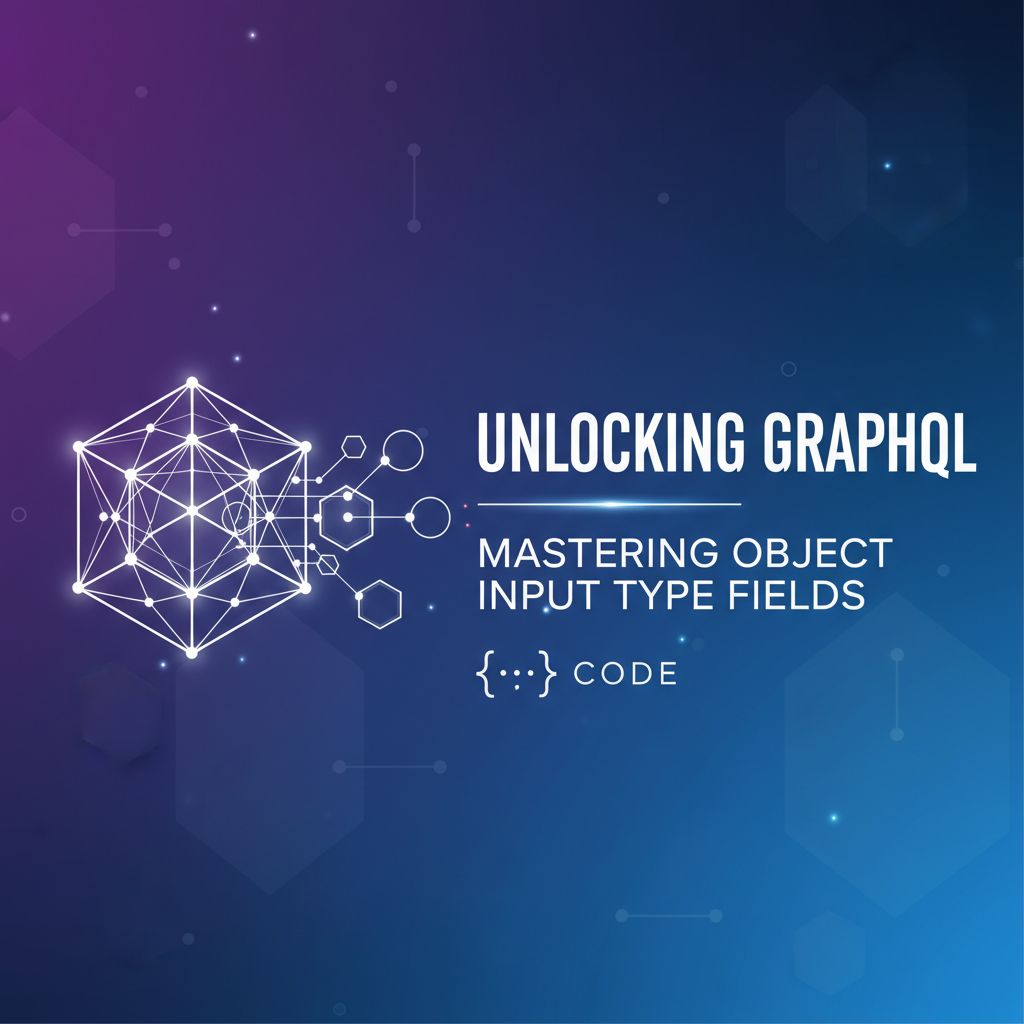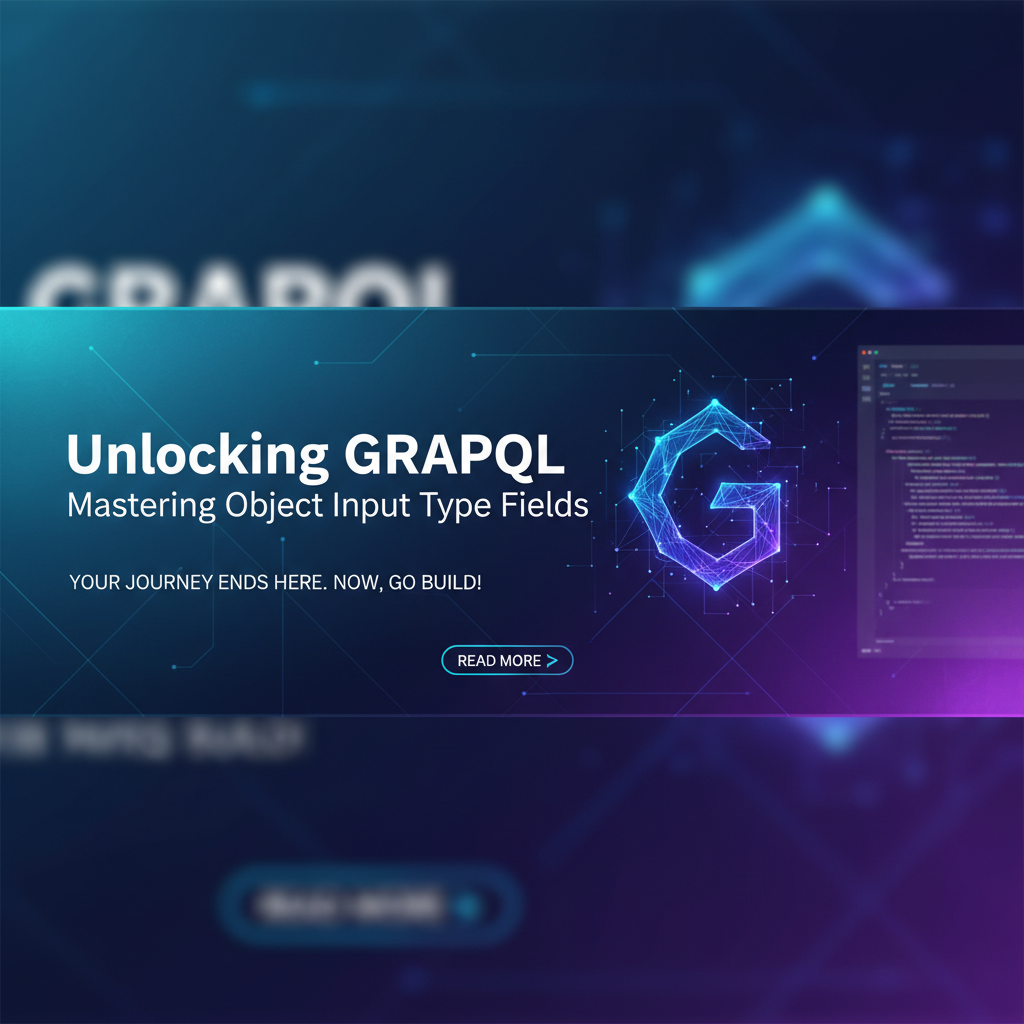Unlocking GraphQL: Mastering Object Input Type Fields

GraphQL, a powerful and flexible data query language, has revolutionized the way developers interact with APIs. One of the most intriguing features of GraphQL is the object input type fields. These fields allow developers to pass complex data structures as input parameters to their queries and mutations, enabling more dynamic and powerful interactions with the API. In this comprehensive guide, we will delve into the intricacies of object input type fields in GraphQL, providing you with the knowledge to harness their full potential.
Understanding GraphQL
Before we dive into object input type fields, it's essential to have a solid understanding of GraphQL. GraphQL is a query language for APIs and a runtime for executing those queries with your existing data. It allows clients to request exactly the data they need from an API, making it more efficient than traditional RESTful APIs, which often require multiple requests to fetch all the desired data.
Key Concepts in GraphQL
- Type: A type is a named set of fields and their types. Types can be objects, interfaces, unions, or enums.
- Query: A query is a request for data from a GraphQL server. It consists of a selection set that specifies which data to fetch.
- Mutation: A mutation is a way to perform write operations on a GraphQL server, such as creating or updating data.
- Field: A field is a specific piece of data that can be requested from a type.
- Argument: An argument is a value that is passed to a field, which can be used to filter or modify the data that is returned.
Exploring Object Input Type Fields
Object input type fields are a crucial component of GraphQL, allowing developers to pass complex data structures as input parameters to their queries and mutations. These fields enable more dynamic and powerful interactions with the API, as they allow for the passing of nested data and complex relationships.
What Are Object Input Type Fields?
An object input type field is a field that accepts an object as its value. This object can contain multiple properties, each with its own type. These properties can be of any type, including other object types, allowing for the creation of complex and nested data structures.
Syntax of Object Input Type Fields
The syntax for defining an object input type field is similar to defining a regular object type. Here's an example:
type Query {
user(id: ID!): User
}
type User {
id: ID!
name: String!
email: String!
profilePicture: Image
}
input UserProfileInput {
name: String!
bio: String
age: Int
}
type Mutation {
updateUser(id: ID!, profile: UserProfileInput!): User
}
In this example, UserProfileInput is an object input type field that accepts a User object with properties name, bio, and age.
Benefits of Using Object Input Type Fields
- Complex Data Structures: Object input type fields allow for the passing of complex data structures, enabling more dynamic and powerful interactions with the API.
- Improved Data Validation: By using object input type fields, developers can ensure that the data being passed to the API is valid and conforms to the expected structure.
- Enhanced Flexibility: Object input type fields provide greater flexibility in terms of how data can be structured and passed to the API.
Practical Examples
Let's look at a couple of practical examples to illustrate the use of object input type fields.
Example 1: Creating a User
mutation createUser {
createUser(input: { name: "John Doe", email: "john.doe@example.com", profile: { bio: "Developer", age: 30 } }) {
id
name
email
profile {
bio
age
}
}
}
In this example, we are creating a new user with a name, email, and profile information using the createUser mutation. The input argument is an object that contains the user's data, including the profile object.
Example 2: Updating a User's Profile
mutation updateUserProfile {
updateUser(id: "123", profile: { bio: "Developer and gamer", age: 31 }) {
id
name
email
profile {
bio
age
}
}
}
In this example, we are updating the profile of an existing user with a new bio and age using the updateUser mutation. The profile argument is an object that contains the updated user profile information.
APIPark is a high-performance AI gateway that allows you to securely access the most comprehensive LLM APIs globally on the APIPark platform, including OpenAI, Anthropic, Mistral, Llama2, Google Gemini, and more.Try APIPark now! 👇👇👇
Best Practices for Using Object Input Type Fields
When using object input type fields in your GraphQL API, it's important to follow best practices to ensure that your API is robust, maintainable, and easy to use.
- Use Descriptive Field Names: Choose clear and descriptive field names to make your API easier to understand.
- Document Your API: Provide comprehensive documentation for your API, including examples of how to use object input type fields.
- Validate Input Data: Validate the input data to ensure that it meets the expected structure and data types.
- Handle Errors Gracefully: Implement proper error handling to provide meaningful error messages to clients when their input data is invalid.
APIPark: Simplifying GraphQL Development
Developing with GraphQL can be complex, especially when dealing with object input type fields. To simplify the process, developers can leverage tools and platforms like APIPark, an open-source AI gateway and API management platform.
Key Features of APIPark
- Quick Integration of 100+ AI Models: APIPark allows for the integration of various AI models with a unified management system for authentication and cost tracking.
- Unified API Format for AI Invocation: It standardizes the request data format across all AI models, ensuring that changes in AI models or prompts do not affect the application or microservices.
- Prompt Encapsulation into REST API: Users can quickly combine AI models with custom prompts to create new APIs, such as sentiment analysis, translation, or data analysis APIs.
- End-to-End API Lifecycle Management: APIPark assists with managing the entire lifecycle of APIs, including design, publication, invocation, and decommission.
How APIPark Can Help
APIPark can help simplify GraphQL development by providing a comprehensive platform for managing and deploying APIs. Its features, such as the unified API format for AI invocation and end-to-end API lifecycle management, can streamline the process of creating and maintaining GraphQL APIs.
Conclusion
Object input type fields are a powerful feature of GraphQL that allow developers to pass complex data structures as input parameters to their queries and mutations. By understanding and utilizing these fields effectively, developers can create more dynamic and flexible APIs. With tools like APIPark, the process of GraphQL development can be further simplified, making it easier for developers to build and maintain robust and efficient APIs.
FAQs
1. What is GraphQL? GraphQL is a query language for APIs and a runtime for executing those queries with your existing data. It allows clients to request exactly the data they need from an API, making it more efficient than traditional RESTful APIs.
2. What are object input type fields? Object input type fields are a type of field in GraphQL that accepts an object as its value. These fields allow developers to pass complex data structures as input parameters to their queries and mutations.
3. Why are object input type fields useful? Object input type fields are useful because they enable more dynamic and flexible interactions with the API, allowing for the passing of complex data structures and nested relationships.
4. Can you provide an example of using object input type fields? Certainly! Here's an example of a GraphQL mutation that uses an object input type field to update a user's profile information:
mutation updateUserProfile {
updateUser(id: "123", profile: { bio: "Developer and gamer", age: 31 }) {
id
name
email
profile {
bio
age
}
}
}
5. How can APIPark help with GraphQL development? APIPark can help simplify GraphQL development by providing a comprehensive platform for managing and deploying APIs. Its features, such as the unified API format for AI invocation and end-to-end API lifecycle management, can streamline the process of creating and maintaining GraphQL APIs.
🚀You can securely and efficiently call the OpenAI API on APIPark in just two steps:
Step 1: Deploy the APIPark AI gateway in 5 minutes.
APIPark is developed based on Golang, offering strong product performance and low development and maintenance costs. You can deploy APIPark with a single command line.
curl -sSO https://download.apipark.com/install/quick-start.sh; bash quick-start.sh

In my experience, you can see the successful deployment interface within 5 to 10 minutes. Then, you can log in to APIPark using your account.

Step 2: Call the OpenAI API.



